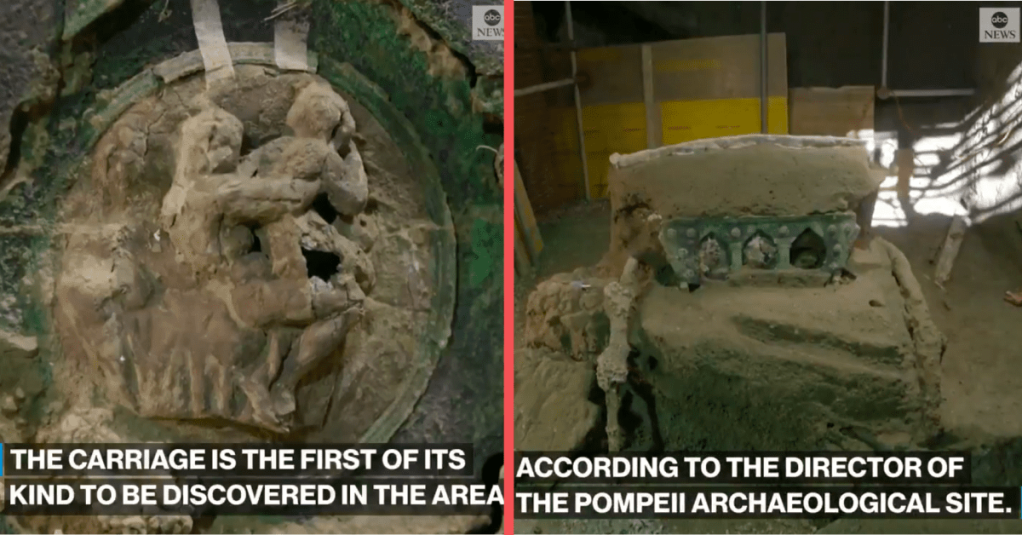It’s amazing to think that even 2,000 years after the city of Pompeii was destroyed, there is still something left to discover.
But earlier this year, archaeologists literally uncovered a remarkable new find.
As originally announced on PompeiiSites.org, researchers discovered a fancy chariot, unlike any they had ever seen before.
Best of all, it was still intact.
In case you missed it during history class, NPR explains:
The ancient city of Pompeii has been the subject of fascination and archaeological digs for hundreds of years. It was buried in volcanic ash from Mount Vesuvius nearly 2,000 years ago, a disaster that preserved in incredible detail the buildings and ephemera of the city and even the shapes of the bodies of the Romans who once walked the city’s streets.
It’s an archaeologist and anthropologist’s dream scenario, except for the mass extinction part.
While previous excavations had yielded everyday vehicles used for travel and work, this ceremonial chariot is the first find of its kind to be discovered, explained Massimo Osanna, the outgoing director of the site.
“It is an extraordinary discovery for the advancement of our knowledge of the ancient world,” Osanna said in a statement.
Researchers, astonished by the find, took to Twitter to express their delight.
Boasting “four iron wheels, metal armrests and backrests, and a seat perched atop that could sit one or two people,” the vehicle was clearly not for every day use.
Notably, the chariot is adorned with metal medallions depicting satyrs, nymphs and cupids, suggesting the possibility that it may have been used in marriage ceremonies.
“… incredible in its completeness, with traces of its cushions, ropes to hold its garlands of flowers, and even the imprint of two ears of wheat left on a seat… [a] parade carriage, painted in red…”
The details are extraordinary.
Via @StevenEllis74 https://t.co/TuBp9fxj1y
— Dr Sophie Hay (@pompei79) February 27, 2021
Archaeologists say that the chariot was so well preserved because the ancient “garage” it was parked in had collapsed around it.
After making the discovery, they had to liberate it from the lava and ash through a process known as micro excavation:
It was a tedious and labor intensive process, in which they took steps along the way to capture remnants or impressions of materials that have long since turned to dust.
At the same time, whenever a void was discovered, plaster was poured in as part of an attempt to preserve the imprint of the organic material that was no longer present. It has been possible to preserve the shaft and platform of the chariot, as well as the imprints of ropes pic.twitter.com/CqcGcU67VG
— Pompeii Sites (@pompeii_sites) March 3, 2021
They worked tirelessly to complete the preservation of their precious find.
Given the fragility of the chariot and the risk of possible illegal operations and damage caused by news leaks, the team has worked every weekend since mid-January, both to guarantee its conservation but also to send a strong signal of the Park’s action to protect the heritage. pic.twitter.com/6wRluRgHcR
— Pompeii Sites (@pompeii_sites) March 3, 2021
And once they were able, they moved the chariot to a lab, where they could further restore the piece in private.
Completed the in situ micro-excavation, the elements of the chariot have been transported to the laboratory, where the restorers are working to complete the removal of volcanic material which engulfs metal elements and to begin the restoration and reconstruction of the chariot. pic.twitter.com/PHWNTZ9yUj
— Pompeii Sites (@pompeii_sites) March 3, 2021
There they could also use equipment like laser scanners to further document and study the artifact.
What has emerged has been systematically recorded via careful photographic documentation and through laser scanner surveying pic.twitter.com/JjU3seyUhj
— Pompeii Sites (@pompeii_sites) March 3, 2021
For a more in-depth look at the preservation process, check out this video:
What an incredible and unique discovery. It really is amazing that after hundreds of years of excavation there’s still more left to find.
What is your favorite piece of history? Let us know in the comments.






